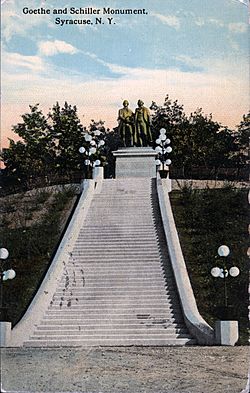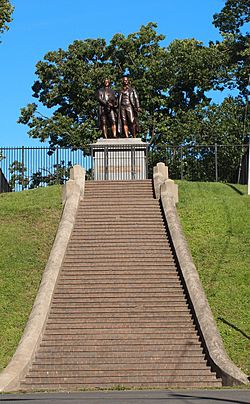Goethe–Schiller Monument (Syracuse) facts for kids
The Goethe–Schiller Monument in Syracuse, New York is a statue of two famous German poets. Their names were Johann Wolfgang von Goethe (born 1749, died 1832) and Friedrich Schiller (born 1759, died 1805). German-American groups in Syracuse and Onondaga County built this monument. It was first shown to the public on October 15, 1911.
Schiller, who is on the right side of the statue, was known as the "poet of freedom" in the United States. Many people admired him in the 1800s. The Syracuse monument was the last of 13 statues built for Schiller in US cities. Goethe was considered a "supreme genius" of German writing. He and Schiller are together in the statue because they had a very special friendship. In the statue, Goethe gently places his hand on Schiller's shoulder. This might show him calming Schiller's strong passion for freedom. Goethe holds a laurel wreath, and Schiller reaches for it.
The Goethe–Schiller Monument in Syracuse looks like an older monument from 1857 in Weimar, Germany. A sculptor named Ernst Rietschel created the original bronze statue for Weimar. The Syracuse monument is an exact copy, just like three earlier US monuments. You can find the Syracuse monument in Schiller Park. This park was renamed in 1905 to honor Schiller. The statue stands on a tall, black marble base. It is at the top of a steep hill, with a grand staircase leading up to it.
Building these monuments in the US was expensive and took many years of fundraising. Their opening ceremonies brought huge crowds. For example, 65,000 people attended the opening of the Goethe–Schiller monument in Cleveland, Ohio, in 1907. The Syracuse Herald newspaper reported on the Syracuse dedication:
Impressive ceremonies marked the unveiling of the Schiller–Goethe monument in Schiller park yesterday afternoon. Thousands of German citizens of Syracuse and thousands of others who appreciate the gift German residents have made to the city were present when Miss Lulu E. Dopffel pulled the cord that released the flags and exposed the beautiful memorial to view.
It was a scene long to be remembered. The plateau of Schiller park, rising high above its surroundings and topped with the bronze figures of the German poets, was thronged with men and women and children. Hundreds were there who had never visited Schiller park. Scores of banners of the marching societies, American flags and brilliant uniforms added to the beauty of the scene.
Why These Poets Were So Important
The original Weimar monument started a huge wave of admiration for these poets. It was unusual for its time. Before the 1850s, it was rare to build expensive statues for poets or thinkers. Having two people in one statue was also uncommon. Plus, showing them in everyday clothes was new. But this monument was very successful. It set a trend for many other statues of the poets that followed.
By 1859, which was 100 years after Schiller's birth, he became known as the "poet of freedom and unity" for German citizens. This was celebrated in 440 events across German lands. For example, in his 1787 play, Don Carlos, Schiller wrote about freedom. People from all walks of life, from plumbers to writers, praised Schiller as a champion of freedom and German unity.
Between 1850 and World War I (1914), about 60 monuments to Schiller or Goethe were built in German-speaking Europe. During the same time, four million German-speakers moved to the United States. Schiller remained very important to these immigrants. His writings helped them feel like true American citizens while keeping their German heritage. By the late 1800s, German-Americans also started building many monuments. They put up at least 15 more statues of the poets before World War I.
In 1900, Syracuse and Onondaga County had about 168,000 people. Nearly 10,000 of them were born in German-speaking countries. With their children, it was estimated that over 25,000 people spoke German. In May 1905, there were many celebrations for 100 years since Schiller's death. Round Top Park was renamed Schiller Park on July 3, 1905. Soon after, planning began for the Goethe–Schiller Monument.
The monument was quite costly. In Syracuse, special "German Day" celebrations in 1908, 1909, and 1910 helped raise money for it. The Goethe–Schiller Monument in Milwaukee, built in 1908, cost about $15,000. The Syracuse monument, built three years later, likely cost a similar amount. To compare, building a large church in Syracuse in 1901 also cost about $15,000.
The 1911 Syracuse monument was one of the last built in the style started by the original Weimar statue 54 years earlier. Some historians believe these grand US monuments were a way for German-Americans to say goodbye to the "Schiller cult" in its popular form. While the Weimar monument is still very famous in Germany, the original meaning of the US monuments is mostly forgotten today.
How the Monument Was Made and Fixed
The first three Goethe–Schiller monuments in the US were in San Francisco (1901), Cleveland (1907), and Milwaukee (1908). All of these used bronze sculptures made in a German factory. The original statue in Weimar is also bronze. However, the statue in Syracuse is different. It is not a solid casting. Instead, it is made of thin pieces of copper joined together.
A small plaque on the statue's base says "Galvanoplastik-Geislingen St." This means it was made by the "Galvanoplastic Division" of the WMF Company in Germany. "Galvanoplastik" refers to a process called electrotyping. This process uses electricity to deposit thin layers of copper onto the inside of a mold. The copper pieces are then joined, usually by soldering, to form the statue. These pieces are very thin, less than an inch thick. The Syracuse sculpture is likely the only copy of Rietschel's statue made this way. It might also be the only public artwork in the US created by WMF.
If you compare an old postcard from 1913 with a recent photo, you can see that the decorative lights on the staircase leading to the monument are gone. By 2001, the monument was in poor condition due to weather and damage. The German-American Society of Central New York worked with the city of Syracuse to fix it. In 2003, artist Sharon BuMann restored the statue. At the same time, the stone base was cleaned, the staircase was repaired, and a decorative iron fence was added around the statue and its base.




